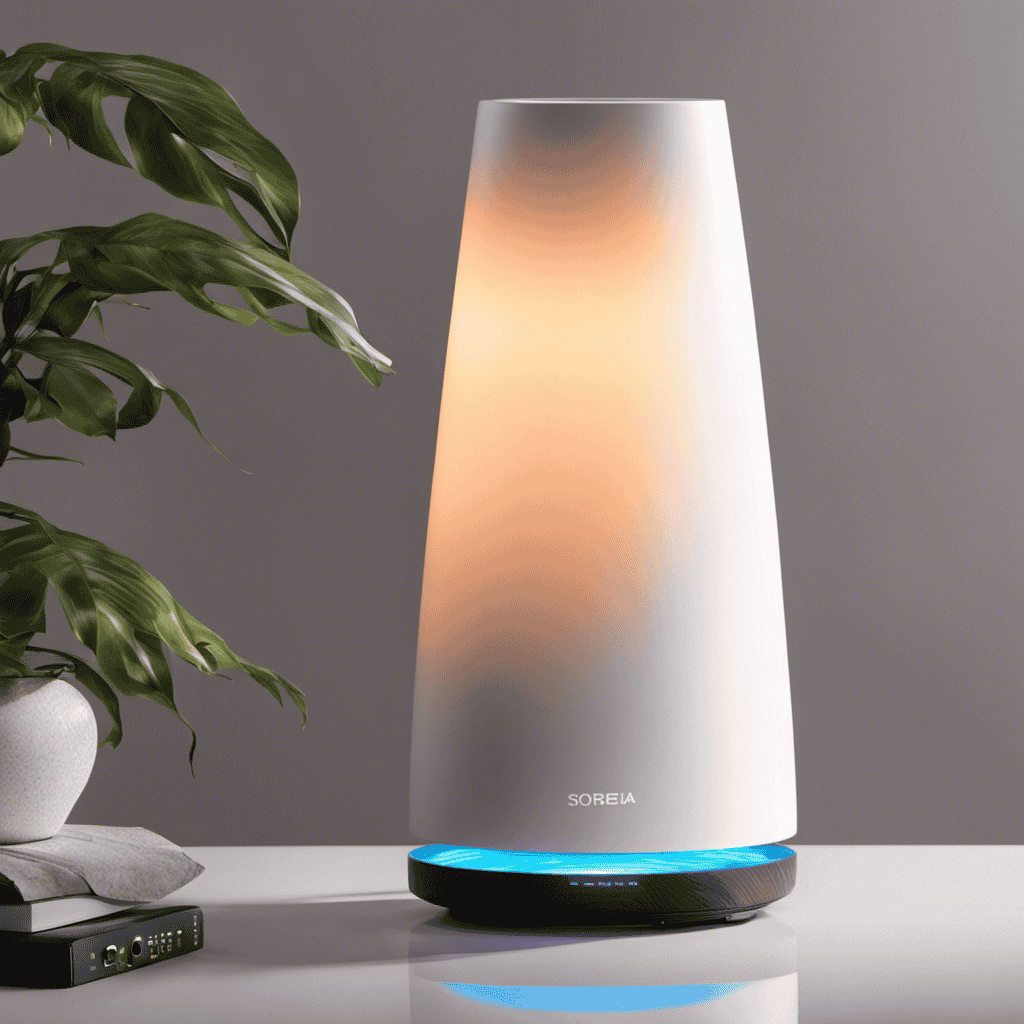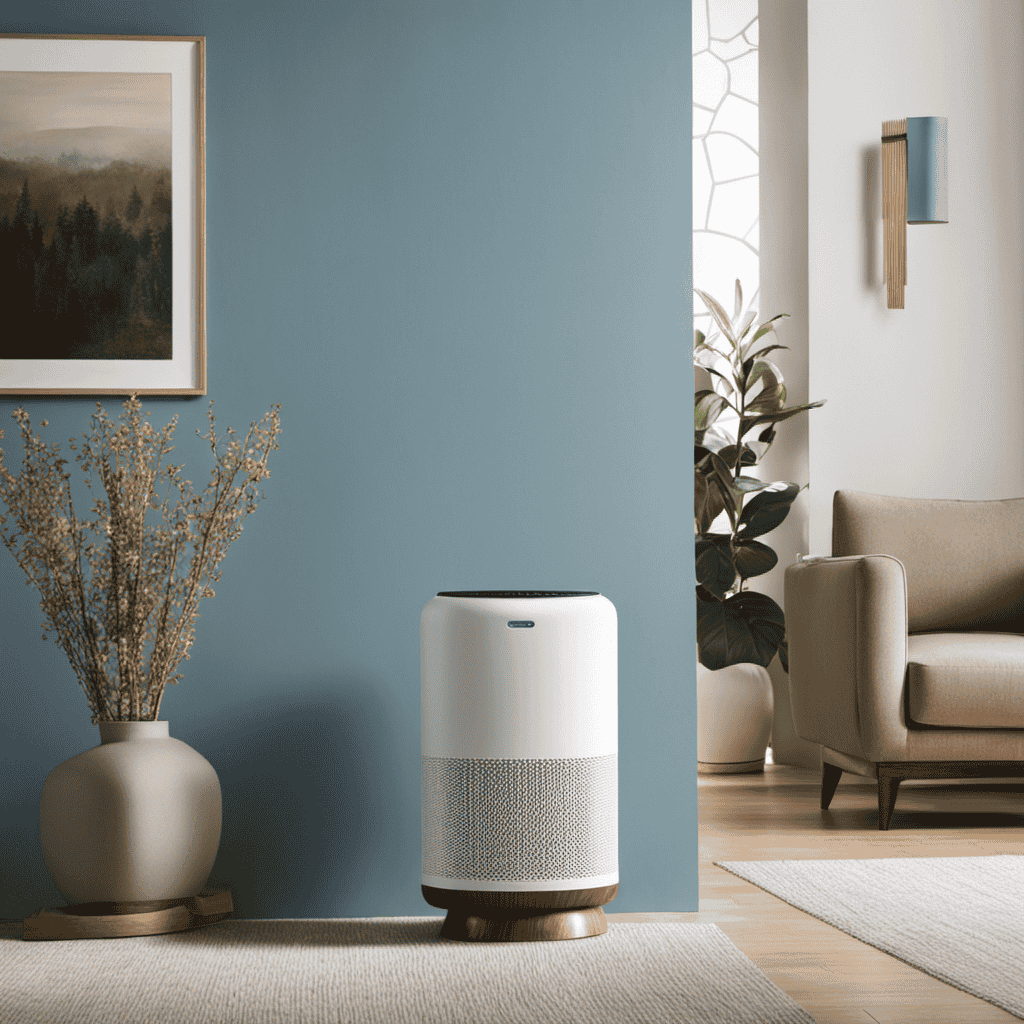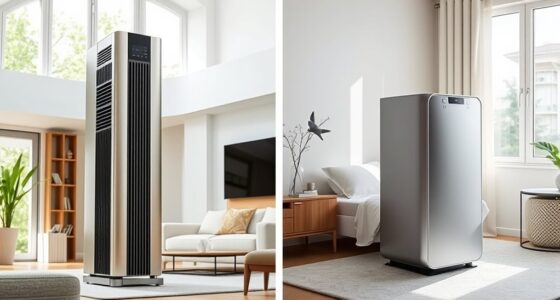Filterless air purifiers do work without traditional filters by using advanced technologies like ionization, electrostatic plates, plasma, or photocatalytic oxidation. These methods attract, neutralize, or oxidize pollutants such as dust, allergens, bacteria, and VOCs. While they may not always be as effective as HEPA filters, they generally require less maintenance and have a lower environmental impact. To understand how they compare and find the best option for you, explore further.
Key Takeaways
- Filterless air purifiers use technologies like ionization, electrostatic attraction, or plasma to remove airborne pollutants without traditional filters.
- They are effective at reducing certain particles like dust, allergens, and microbes but may be less efficient for larger or heavier debris.
- These devices typically require less maintenance and have lower ongoing costs compared to filter-based purifiers.
- Some filterless models can produce ozone or other emissions, requiring proper operation and safety considerations.
- Their overall effectiveness depends on the technology used and specific air quality needs, making them suitable for certain environments.
How Do Filterless Air Purifiers Function?

Filterless air purifiers work by using advanced technologies that eliminate pollutants without the need for traditional filters. Instead of relying on replaceable filters, these devices often utilize electrostatic or ionization methods to clean the air. As air flows through the purifier, charged ions or electrostatic plates attract and neutralize airborne particles like dust, pollen, and bacteria. This process helps improve your air quality efficiently. Because there are no filters to replace regularly, your device’s lifespan can be longer, reducing maintenance costs. Additionally, the integration of automation technologies in some models allows for smarter operation and monitoring. Proper operation is necessary because some technologies can produce ozone, which can impact indoor air quality. Understanding AI’s role in environmental technology can help consumers make informed choices about filterless air purifiers. Moreover, selecting a device with proper safety features ensures safe operation and minimizes potential risks. Being aware of air purification standards can further assist in choosing a reliable model. Overall, filterless models offer a maintenance-friendly option that effectively enhances air quality over time.
Types of Technologies Used in Filterless Models
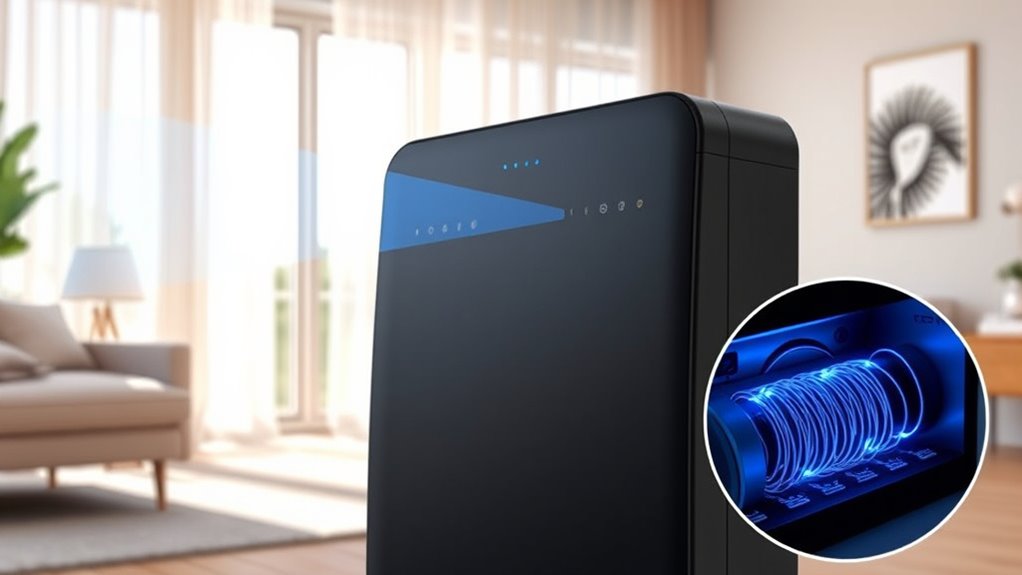
You’ll find that filterless air purifiers use a variety of innovative technologies to clean the air. Technologies like Plasma Cluster, photocatalytic oxidation, and ionizers with ozone generation each have unique ways of neutralizing pollutants. Understanding how these methods work helps you choose the right model for your needs.
Plasma Cluster Technology
Plasma Cluster Technology is a popular method used in filterless air purifiers to reduce airborne particles and bacteria. It works by releasing ionized molecules that attach to dust, allergens, and microbes, causing them to clump together and settle out of the air. When choosing where to place your purifier, consider that Plasma Cluster units are often compact, so they can fit comfortably in various locations. However, noise level considerations are important—these devices can produce a humming or high-pitched sound, especially at higher settings. To minimize disruption, place the purifier away from quiet spaces like bedrooms or offices. Proper placement guarantees effective operation while keeping noise levels manageable, helping you enjoy cleaner air without disturbances. Additionally, understanding AI-powered innovations in air purification can enhance your ability to select the most effective models. Employing sound design techniques in the development of these devices can improve user experience by reducing operational noise and enhancing overall comfort. Moreover, the integration of certifications and endorsements from reputable sources can assist consumers in verifying the authenticity and quality of these filterless systems. Incorporating advanced filtration methods can further optimize the performance and safety of plasma-based air purifiers, especially as new technologies evolve to enhance efficiency and user satisfaction.
Photocatalytic Oxidation Process
Photocatalytic oxidation (PCO) is an innovative technology often found in filterless air purifiers that targets airborne pollutants at a molecular level. It combines a photocatalyst, usually titanium dioxide, with UV sterilization to break down organic compounds, bacteria, and viruses. When UV light hits the photocatalyst, it creates reactive radicals that oxidize contaminants, transforming them into harmless substances like carbon dioxide and water. This process effectively reduces odors, volatile organic compounds (VOCs), and microbial presence without relying on traditional filters. PCO systems are valued for their continuous purification capabilities and low maintenance. While not as fast as some methods, they provide ongoing air cleaning by actively neutralizing pollutants in real-time, making them a popular choice for those seeking filterless solutions. Additionally, the oxidation process can eliminate a broader range of pollutants, including some that are difficult to trap with conventional filters.
Ionizer and Ozone Generation
Ionizers and ozone generators are common technologies in filterless air purifiers, utilizing electrical charges to remove or neutralize airborne particles. They improve air quality by charging particles, causing them to stick to surfaces or each other, reducing airborne contaminants. However, ozone production can be a concern, as high levels may irritate your lungs or worsen respiratory issues. When considering these devices, keep in mind:
- They enhance air circulation by actively moving charged particles out of your breathing zone.
- Proper placement guarantees ideal air quality improvements without ozone buildup.
- Not all models produce safe levels of ozone; check the manufacturer’s specifications.
- Understanding air purification technology can help you choose the most suitable device for your needs.
- Regular monitoring of ozone levels is essential to prevent potential health risks associated with ozone emissions.
- Additionally, awareness of fume and odor removal capabilities can help in selecting devices that address specific indoor air concerns.
- Being informed about ozone safety standards ensures that users choose models that meet health guidelines and minimize risks.
- Researching device maintenance can extend the lifespan and effectiveness of your air purifier.
While effective at reducing certain pollutants, it’s vital to balance their benefits with potential ozone emissions, especially in enclosed spaces.
Effectiveness in Removing Common Indoor Pollutants
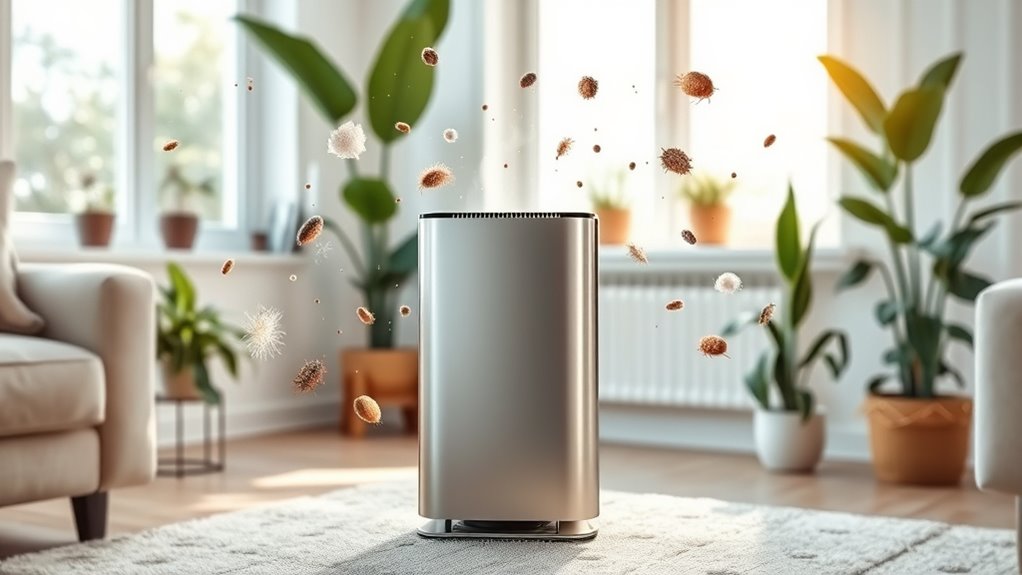
Filterless air purifiers can effectively reduce common indoor pollutants such as dust, pet dander, and smoke particles without the need for replaceable filters. Many air quality myths suggest that filters are the only way to improve indoor air, but filterless designs often use ionization or other technologies to trap particles. A new sentence with technological advancements and the rest of the sentence. This means you don’t have to worry about replacing filters or their lifespan, saving you money and effort. These purifiers can improve air quality in small to medium spaces by capturing airborne pollutants and reducing odors. While they might not remove every allergen, they do a good job of reducing visible dust and smoke. Additionally, ongoing advancements in AI Security help develop smarter and more efficient air purification technologies. For example, newer models incorporate smart sensors that automatically adjust operation based on real-time air quality data. Furthermore, improvements in sensor accuracy enable these devices to better detect and respond to varying indoor air conditions. Overall, filterless air purifiers offer a viable option for maintaining cleaner indoor air without the hassle of filter maintenance.
Comparing Filterless and Traditional Air Purifiers
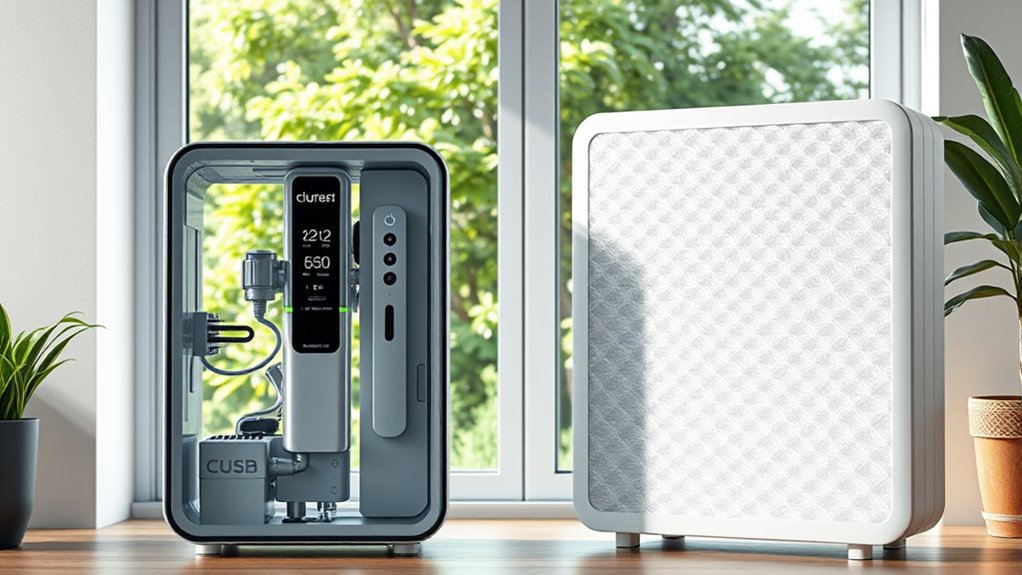
When comparing filterless and traditional air purifiers, you’ll notice differences in how well they trap particles and pollutants. Filterless models often have lower filtration efficiency but require less ongoing maintenance, saving you time and money. Understanding these trade-offs can help you choose the right option for your needs and budget. Additionally, considering the specific types of pollutants each system targets can ensure better air quality for your environment. Since filterless purifiers typically rely on alternative mechanisms like ionization or electrostatic attraction, it’s important to evaluate their effectiveness against harmful pollutants such as smoke and VOCs for comprehensive air cleaning. Exploring filtration technologies can provide further insight into their capabilities and limitations. Recent AI discoveries, such as AI manipulating quantum particles, may someday lead to advanced air purification methods, further transforming the industry.
Filtration Efficiency Differences
How do filterless air purifiers compare to traditional models regarding filtration efficiency? Traditional air purifiers often use HEPA filters and activated carbon to trap particles and odors effectively. In contrast, filterless devices rely on alternative methods like ionization or electrostatic attraction. Electrostatic attraction can be effective for certain pollutants, but its overall efficiency varies depending on the design and usage. Additionally, the maintenance requirements of filterless units tend to be lower since they do not require regular filter replacements, which can be advantageous for users seeking low-maintenance options. While HEPA filters excel at removing dust, pollen, and bacteria, filterless purifiers may struggle with these particles. Activated carbon is excellent for odors and chemical vapors but isn’t a substitute for physical filtration. Key differences include: – Traditional purifiers typically capture a broader range of pollutants due to physical filters. – Filterless models depend on electrical charges, which may be less effective for larger or heavier particles. – Overall, traditional units generally offer higher filtration efficiency for diverse airborne contaminants. – Fiber-based filtration methods in traditional purifiers contribute significantly to their superior performance. Moreover, the effectiveness of filtration technology is also influenced by the operational environment and usage frequency.
Maintenance and Operational Costs
Traditional air purifiers often require regular replacement of filters, which can add up over time. The filter lifespan varies, but most need changing every 6 to 12 months depending on usage and air quality. This replacement frequency contributes to ongoing costs and effort. In contrast, filterless purifiers generally have lower maintenance costs since they lack replaceable filters. Instead, they rely on electronic components that typically last several years, reducing replacement expenses. While initial costs for filterless units might be higher, their long-term operational costs are often lower. You won’t need to budget for frequent filter purchases or disposal, making them more cost-effective over time. Additionally, filterless systems typically require less maintenance and fewer replacement parts, further lowering ongoing expenses. Overall, filterless purifiers can save you money and hassle on maintenance, especially if you prefer minimal upkeep.
Maintenance and Operating Costs of Filterless Devices
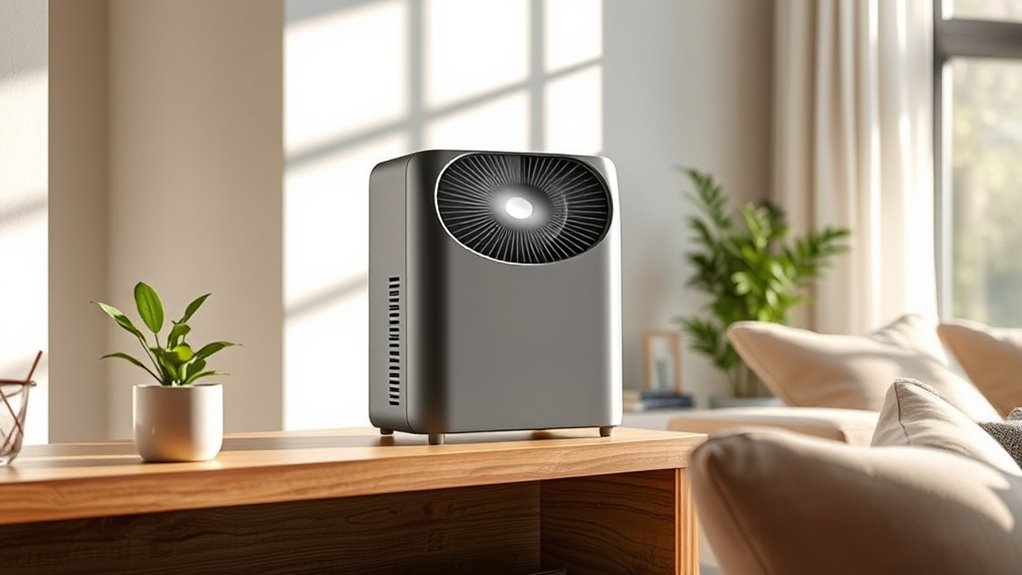
Since filterless air purifiers lack replaceable filters, they generally require less ongoing maintenance and have lower operating costs. You won’t need to worry about frequent filter replacements, which can be costly and time-consuming. Instead, you might focus on cleaning the device periodically to maintain peak performance. The filter lifespan for filterless models is usually longer, reducing the need for replacements altogether. Additionally, these purifiers often consume less energy, saving you money on electricity bills. Keep in mind, though, that some models may require specific maintenance routines to prevent dust buildup or ensure proper airflow.
- Minimal maintenance, mostly just cleaning
- No costs for filter replacement or disposal
- Lower energy consumption over time
Safety Considerations and Potential Risks
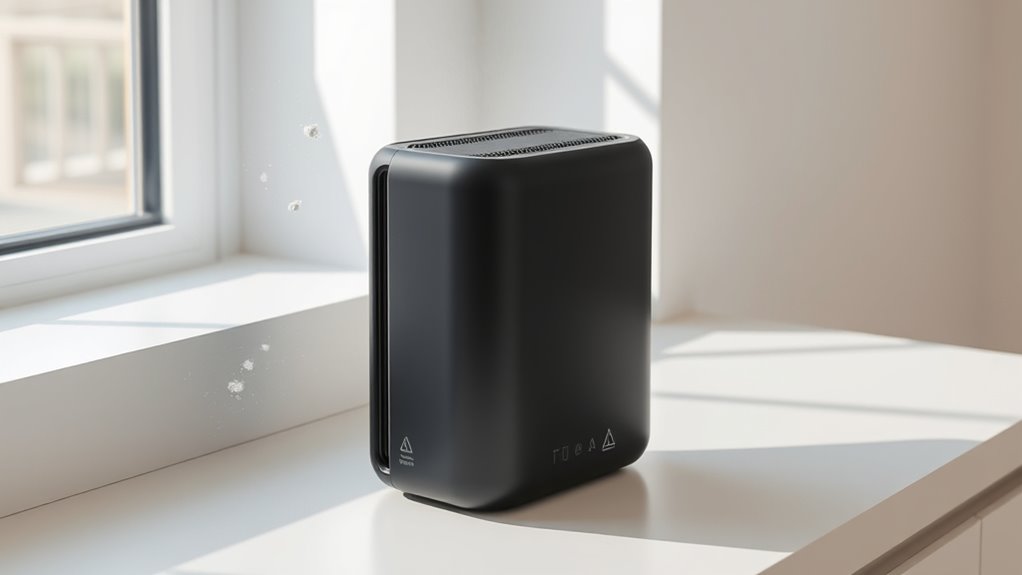
While filterless air purifiers generally pose fewer safety risks than models with replaceable filters, you should still be aware of potential concerns. Some units may emit hazardous emissions if not properly maintained or if they malfunction. For example, certain electronic or ionizing purifiers can produce ozone, which can irritate your lungs and worsen respiratory conditions. Chemical safety is also critical; if the device uses chemicals or generates byproducts, ensure it’s certified safe and doesn’t release harmful substances into your environment. Always follow the manufacturer’s instructions and regularly inspect your purifier for signs of wear or damage. Being cautious helps prevent exposure to hazardous emissions and ensures your air purifier remains a safe addition to your home.
Ideal Environments and Uses for Filterless Purifiers

Filterless air purifiers are best suited for environments where simplicity, low maintenance, and safety are priorities. You’ll find them ideal in spaces like bedrooms, offices, or small living areas where air quality monitoring is essential. These purifiers work well when the focus is on maintaining comfortable indoor humidity and reducing minor pollutants. They’re particularly useful in settings with stable air conditions, where frequent filter changes aren’t required. For peak performance, monitor indoor humidity levels to prevent mold and bacteria growth. Use them in spaces where you want a quiet, low-energy solution to improve air quality. Keep in mind, they’re not designed for heavy pollution, but they excel in maintaining a clean, comfortable environment for everyday use.
Environmental Impact and Energy Efficiency
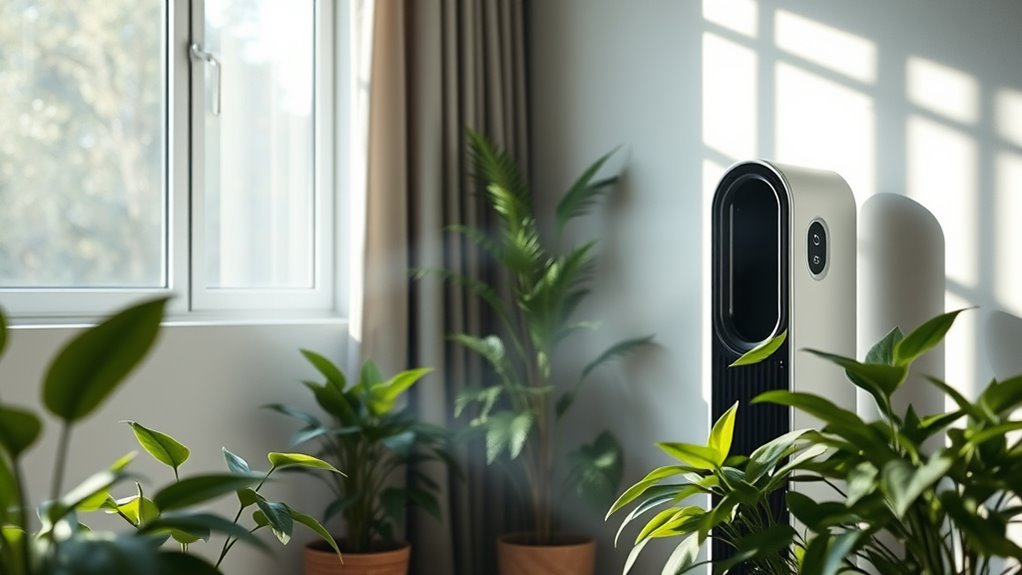
Filterless air purifiers use less energy, helping you save on electricity bills and reduce your carbon footprint. They also often rely on eco-friendly alternatives instead of traditional filters, which minimizes waste. By choosing these options, you can make a positive impact on the environment while maintaining clean indoor air.
Reduced Energy Consumption
Because they operate without traditional filters, filterless air purifiers typically consume less energy than their filter-based counterparts. This leads to notable energy savings and lower power consumption, making them more eco-friendly and cost-effective. With fewer components to operate, these units often run more efficiently, reducing your electricity bill. Additionally, their simpler design means they often require less maintenance and have fewer parts that need replacing. You’ll benefit from consistent airflow without sacrificing performance.
- Lower power consumption reduces your energy bills
- Less frequent maintenance saves time and money
- Simplified design improves overall efficiency and durability
Eco-Friendly Filter Alternatives
Eco-friendly filter alternatives in air purification focus on reducing environmental impact while maintaining energy efficiency. HEPA filters are popular because they effectively trap pollutants and allergens, improving air quality without excessive energy use. However, traditional HEPA filters can be wasteful and energy-intensive to produce and dispose of. Innovative options now include reusable or washable filters, which cut down on waste and conserve resources. Some manufacturers are exploring natural or biodegradable materials that lessen environmental harm. These alternatives not only support sustainability but also often require less energy to operate, making them a smart choice for eco-conscious consumers. By choosing filters that balance performance with environmental responsibility, you can enhance your air quality without compromising your commitment to sustainability.
Common Brands and Top-Rated Models

Several brands stand out in the filterless air purifier market, offering models that combine efficiency and affordability. These units often rely on alternative methods like HEPA filtration and activated carbon to clean the air effectively. Top-rated models include:
- PureAir: Known for its powerful activated carbon filters that absorb odors and VOCs.
- AirZen: Features a combination of HEPA filtration and ionization, ideal for allergies.
- Breeze: Uses a unique electrostatic system to trap particles without traditional filters.
While these brands excel, it’s essential to check if they suit your needs, especially if you require specific filtration capabilities like HEPA or activated carbon. These models prove that you don’t always need traditional filters to maintain clean indoor air.
Tips for Choosing the Right Air Purifier for Your Needs

Choosing the right air purifier depends on your specific needs and living environment. Consider factors like filter lifespan and noise levels to guarantee it fits your lifestyle. If you have allergies or asthma, look for models that target allergens and VOCs. For quieter operation, opt for units with low noise levels, especially if you sleep nearby. Budget for maintenance costs and filter replacement frequency. To help decide, review this quick comparison:
| Feature | Consideration |
|---|---|
| Filter lifespan | Longer lifespan reduces replacement frequency |
| Noise levels | Lower decibels mean quieter operation |
| Room size | Match purifier capacity to your space |
| Air quality needs | Target specific pollutants or allergens |
This approach helps you choose an effective, low-maintenance air purifier tailored to your needs.
Frequently Asked Questions
Can Filterless Purifiers Eliminate Odors Effectively?
You wonder if filterless purifiers can eliminate odors effectively. These units often use adsorption technology, which captures odors on special surfaces, making them quite effective. Some also generate ozone, which reacts with odor molecules to neutralize smells. However, ozone can be harmful in high concentrations, so you should use these purifiers carefully. Overall, filterless models can reduce odors, but their effectiveness varies based on the technology and space size.
Are Filterless Air Purifiers Suitable for Allergy Sufferers?
Imagine breathing fresh air, free from airborne allergens, without worrying about filter maintenance. Filterless air purifiers often use ionization or UV technology, which can help reduce allergens in your space. However, their effectiveness varies, and they might not capture all particles as traditional filters do. If allergies are a concern, consider combining methods or choosing devices specifically designed to target airborne allergens for ideal relief.
How Long Do Filterless Purifiers Typically Last?
You might wonder about the filter lifespan of filterless purifiers. Without traditional filters, these devices usually last longer because they lack filter replacements. However, their components, like fans or UV lights, still require maintenance. Typically, you should clean or replace parts every 6 to 12 months, depending on usage and air quality. Regular maintenance ensures peak performance and extends the device’s lifespan, saving you money and effort.
Do Filterless Models Emit Any Harmful Byproducts?
Did you know that over 75% of air purifier users worry about emission safety? Filterless models generally don’t emit harmful byproducts because they don’t rely on chemical filters. However, some concerns about chemical concerns, like ozone production, do exist. You should check product claims and reviews to confirm your chosen device minimizes emissions, promoting a safer indoor environment without introducing new chemical risks.
Are Filterless Air Purifiers Effective Against Viruses?
You might wonder if filterless air purifiers effectively target viruses. While traditional models with HEPA efficiency excel at viral filtration, filterless options typically rely on ionization or UV light, which may not be as reliable. Ionizer purifiers can reduce airborne viruses, but their effectiveness varies. For the best protection, choose a purifier with proven viral filtration capabilities, ideally with HEPA efficiency, to guarantee cleaner, safer air.
Conclusion
While filterless air purifiers may not be the perfect solution for every situation, they do offer a quiet, low-maintenance alternative worth considering. By understanding their strengths and limitations, you can decide if they’ll harmonize with your indoor environment. Keep in mind, sometimes a gentle breeze of innovation brings just the right touch of freshness. With the right choice, you’ll create a healthier space that feels naturally inviting, without the fuss of traditional filters.



